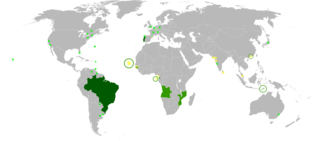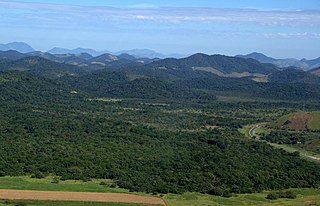| Tinguá Biological Reserve | |
|---|---|
| Reserva Biológica do Tinguá | |
IUCN category Ia (strict nature reserve) | |
Serra do Tinguá mountains | |
| Location | Rio de Janeiro State |
| Nearest city | Rio de Janeiro |
| Coordinates | 22°32′42″S43°23′06″W / 22.545°S 43.385°W Coordinates: 22°32′42″S43°23′06″W / 22.545°S 43.385°W |
| Area | 26,260 hectares (64,900 acres) |
| Designation | Biological reserve |
| Created | 23 May 1989 |
Tinguá Biological Reserve (Portuguese : Reserva Biológica do Tinguá) is a biological reserve in the Serra do Tinguá mountains, Rio de Janeiro state, eastern Brazil.

Portuguese is a Western Romance language originating in the Iberian Peninsula. It is the sole official language of Portugal, Brazil, Cape Verde, Guinea-Bissau, Mozambique, Angola, and São Tomé and Príncipe. It also has co-official language status in East Timor, Equatorial Guinea and Macau in China. As the result of expansion during colonial times, a cultural presence of Portuguese and Portuguese creole speakers are also found in Goa, Daman and Diu in India; in Batticaloa on the east coast of Sri Lanka; in the Indonesian island of Flores; in the Malacca state of Malaysia; and the ABC islands in the Caribbean where Papiamento is spoken, while Cape Verdean Creole is the most widely spoken Portuguese-based Creole. A Portuguese-speaking person or nation may be referred to as "Lusophone" in both English and Portuguese.

A biological reserve in Brazil is a legally defined type of protected area of Brazil, a conservation unit that aims for full preservation of biota and other natural attributes without human interference. It may be visited only with prior approval of the responsible agency, and only for research or educational purposes.

Brazil, officially the Federative Republic of Brazil, is the largest country in both South America and Latin America. At 8.5 million square kilometers and with over 208 million people, Brazil is the world's fifth-largest country by area and the fifth most populous. Brazil borders every South American country except Chile and Ecuador. Its capital is Brasília, and its most populated city is São Paulo. The federation is composed of the union of the 26 states, the Federal District, and the 5,570 municipalities. It is the largest country to have Portuguese as an official language and the only one in the Americas; it is also one of the most multicultural and ethnically diverse nations, due to over a century of mass immigration from around the world.
















